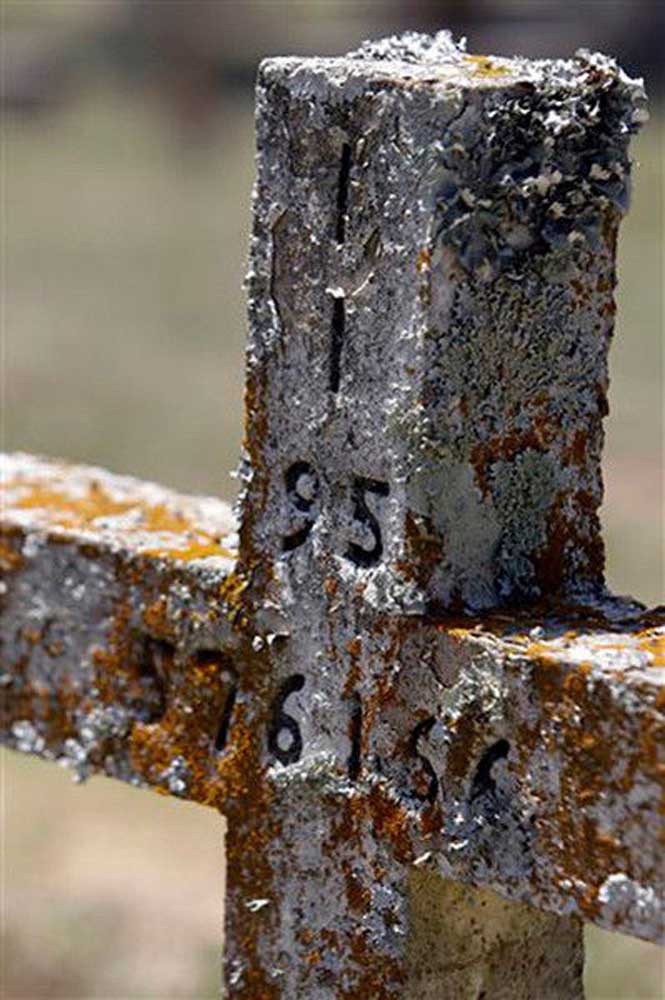Huntsville, Texas: Historian seeks stories behind mystery graves
Published 6:35 pm Friday, October 4, 2013

- In this Aug. 2, 2012 photo, lichens cover a concrete cross that bears only the date of death and prisoner's ID number at Joe Byrd Cemetery, the final resting spot of indigent Texas Department of Criminal Justice prisoners, in Huntsville, Texas. In recent years, names were included on headstones. (AP Photo/Houston Chronicle, Melissa Phillip)
Editor’s note: This is an AP Member Exchange shared by the Houston Chronicle.HUNTSVILLE, Texas (AP) — Near the oldest prison in Texas lies an ornate enclosure holding two strangers and another grave strangely marked with a prisoner’s number.
It’s a set of mysteries that one historian at the Texas Prison Museum wants to clear up before the facts are lost to time.
“With graveyards and fading tombstones there is so much history that we don’t know,” Sandra Rogers told the Houston Chronicle (http://bit.ly/16O9C6r).
Rogers is one of many archaeological stewards for the Texas Historical Commission. People that could possibly know about the site near the Walls Unit in Huntsville are dying every day, but the former teacher is determined to crack the code.
Rogers would like find out why a white inmate, 41-year-old Jim Norton, was buried in a nearby established Southside black cemetery in December 1929, with his inmate number included on his gravestone.
Norton would have been buried at Captain Joe Byrd Cemetery, otherwise known as Peckerwood Hill, with other inmates but his body was claimed by his family.
At the time of Norton’s death, prisoner’s graves were only marked with wooden crosses, but he was given a tablet-style cement stone.
“If he was buried by a family member, why would they include his prison number?” asks Rogers.
Byrd, for whom the cemetery is named, was the assistant warden at the Walls Unit credited with rescuing the site with a massive cleanup and maintenance program in the 1960s. Under Byrd’s direction, unmarked graves were identified and crosses erected over them.
Norton’s history is unique in itself. He was sent to Huntsville in the summer of 1915 and was pardoned by then-Governor James Ferguson. Norton returned to Huntsville in June 1928 on a robbery charge.
His conduct record while at Walls was spotty to say the least, according to Rogers.
She says she found that he racked up 2,878 hours in solitary for mugging a guard and then threatening to escape.
Norton’s cause of death is still unknown.
There is also the mystery of the two women buried separately from everyone else, behind Goree Farm.
Lula Wyatt and S. Mendoza Sotelo are both interred inside a small ornate enclosure. According to Rogers, the pair didn’t serve time simultaneously and didn’t even know one another.
Wyatt was working on a five-year stretch for murder when she died in December 1931 at the age of 53 due to causes unknown. Sotelo didn’t arrive at the prison until the next June to serve a three-year sentence for narcotics possession.
Sotelo, 32, passed away two months later that August due to heart disease.
According to Rogers, the Texas Department of Criminal Justice sold the land to Elkins Lake in 1996, with six graves on the property subsequently relocated. The graves of Wyatt and Sotelo were not moved.
To fill in the blanks surrounding some of the dates and faces from Texas prison history, Rogers has gone as far as placing ads in various Texas newspapers, hoping that the pictures she includes will jog someone’s memory. Sometimes it works. She’s spoken with a few inmates from the ’50s, along with employees who may have heard something while they were incarcerated or on the payroll.
So far, no one has come forward to let Rogers or anyone else at the museum know just why these three bodies were interred where they were. It’s difficult to figure out who is who in inmate photos because of the use of microfilm.
Rogers doesn’t even know what Wyatt, Sotelo, and Norton looked like._
Information from: Houston Chronicle,
Copyright 2013 The Associated Press. All rights reserved. This material may not be published, broadcast, rewritten or redistributed.






